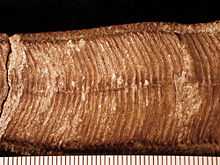Conulariida
| Conulariida Temporal range: Upper Cambrian–Triassic | |
|---|---|
 | |
| Conulariid from the Mississippian of Indiana; scale in mm. | |
| Scientific classification | |
| Kingdom: | Animalia |
| Phylum: | Cnidaria |
| Class: | Scyphozoa |
| Order: | †Conulariida |
| Families | |
|
See text. | |
The Conulata, also known as conulariids, form a poorly understood clade of extinct scyphozoan cnidarians.
Structure
The conulariids are fossils preserved as shell-like structures made up of rows of calcium phosphate rods, resembling an ice-cream cone with fourfold symmetry, usually four prominently-grooved corners.[1] New rods were added as the organism grew in length; the rod-based growth falsely gives the fossils a segmented appearance. Exceptional soft-part preservation has revealed that soft tentacles protruded from the wider end of the cone, and a holdfast from the pointed end attached the organisms to hard substrate. The prevailing reconstruction of the organism has it look superficially like a sea anemone sitting inside an angular, hard cone held perpendicular to the substrate.
Fossil record

Setting aside for the moment the Precambrian Vendoconularia, which may or may not be conulariids at all,[2] the Conulata fossil record begins with undoubted specimens in the Upper Cambrian (Hughes et al., 2000) and extends without significant break through numerous major mass extinctions. The Conulariids finally disappear from the rock record during the Lower Triassic stage of the Triassic Period (~245 million years ago).
In North America, conulariids are generally least uncommon in rocks of Ordovician and Carboniferous age.
Lifestyle
Conulariids apparently lived only in normal-marine waters, such as the oceans and inland seas. Fossils are commonly found in rocks representing offshore, even anoxic, marine bottom environments. This has led some scientists to infer that these animals may have drifted planktonically for some or all of their lives, ultimately being buried in the anoxic sediments beneath the oxic waters in which they lived. However, basic functional considerations (such as the great weight of the shell) make such interpretations difficult to maintain.
Phylogeny
About 20 genera and 150 species are known, but except for local occurrences, Conulariids are relatively uncommon.
The conulariids were originally thought to be anthozoan cnidarians. However, the lack of septa or other features diagnostic of anthozoans led researchers to abandon this hypothesis. Ivantsov and Fedonkin (2002) posit that the conulariids were ancestrally tri-radially symmetrical, as typified with Vendoconularia, typical of the structure seen in Vendozooans. Conulariids are, however, not generally thought to be a part of the Ediacaran biota as their fossil record starts at Upper Cambrian. The conulariids are now thought to be most closely related to the Scyphozoa, or the "true jellyfish".
It is now also thought that the conulate trilobozoans derived their fourfold symmetry from a sixfold symmetry, as seen in Vendoconularia. This in turn, is thought to be originally derived from an ancestral disk-like trilobozoan three-fold symmetry.
Conulariids are generally thought to be of Cnidarian affinity, occupying a position near the base of the Cnidarian family tree. However, the nature of Conulariids and their phylogenetic relationships to other organisms remain poorly understood, and the supposed cnidarian affinity remains speculative.
Conulariid pearls
Conulariids produced pearls within their shells, similar to the way molluscs such as oysters, other pelecypods, and some gastropods do today. These pearls give a clue as to the internal anatomy of the conulariid animal. But due to their calcium phosphate composition, their crystal structure, and their extreme age, these pearls tend to be rather unattractive for use in decorative objects.
List of Genera
- Aciconularia
- Adesmoconularia
- Anaconularia
- Archaeoconularia
- Australoconularia
- Barbigodithreca
- Calloconularia
- Circonularia
- Climacoconus
- Conchopeltis
- Conomedusites
- Conulariella
- Conularina
- Conulariopsis
- Ctenoconularia
- Diconularia
- Eoconularia
- Exoconularia
- Flectoconularia
- Garraconularia
- Glyptoconularia
- Gondaconularia
- Hexangulaconularia
- Holoconularia
- Mabianoconullus
- Mesoconularia
- Metaconularia
- Neoconularia
- Notoconularia
- Palaenigma
- Paraconularia
- Pseudoconularia
- Quadrosiphogonuchites
- Reticulaconularia
- Tasmanoconularia
External links
- Zdenka Brabcova and Petr Kraft (2003-06-15). "The Conulariida: Mystery fossils". Retrieved 2008-02-04.
- http://www.uga.edu/strata/cincy/fauna/conulariida/Conularia.html
- Ben M. Waggoner and David Smith (6/13/94 – 11/22/94). "Study of conulariid and related phosphatic conical exoskeletons from the Prague Basin (Czech Republic)". Retrieved 2007-08-11.
References
- ↑ Waggoner, B.M. & D. Smith (1994): The Conulariida, Mystery fossils. University of California Museum of Paleontology web page
- ↑ Van Iten, H.; De Moraes Leme, J.; Coelho Rodrigues, S.; Guimaraes Simoes, M. (2005). "Reinterpretation of a Conulariid-Like Fossil from the Vendian of Russia". Palaeontology 48 (3): 619–622. doi:10.1111/j.1475-4983.2005.00471.x.
- Babcock, L. E., Feldmann, R. М. (1986). "Devonian and Mississippian conulariids of North America. Part A. General description and Conularia". Annals of Carnegie Museum 55: 349–410.
- Babcock, L. E. (1991). "The enigma of conulariid affinities". In A. M. Simonetta and S. Conway Morris. The Early Evolution of Metazoa and the Significance of Problematic Taxa. Cambridge: Cambridge University Press. pp. 133–143.
- Hughes, N. C., Gunderson, G. D. and Weedon, M. J. (2000). "Late Cambrian conulariids from Wisconsin and Minnesota". Journal of Paleontology 74: 828–838.
- Ivantsov, A. Y.; Fedonkin, M. A. (2002). "Conulariid-like fossil from the Vendian of Russia: a metazoan clade across the Proterozoic/Palaeozoic boundary" (Free full text). Palaeontology 45 (6): 1119–1129. doi:10.1111/1475-4983.00283.
- Van Iten, H. (1991). "Evolutionary affinities of conulariids". In A. M. Simonetta and S. Conway Morris. The Early Evolution of Metazoa and the Significance of Problematic Taxa. Cambridge: Cambridge University Press. pp. 145–155.